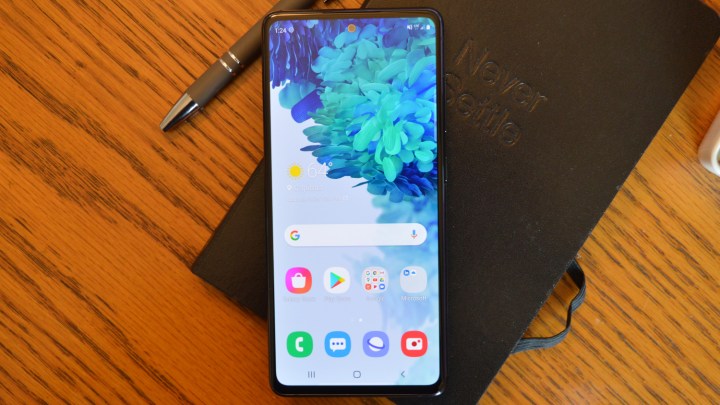Smartphones are getting more and more expensive, but that doesn’t mean you have to spend $1,000 or more to get a quality device. A premium midrange market has appeared, and competition is particularly fierce this year.
Two of the most significant models to come out this year have to be the Samsung Galaxy S20 Fan Edition (FE) and the OnePlus 8T. The Samsung Galaxy S20 FE is a toned-down Galaxy S20, swapping out some of the more premium features to make a “bare essentials” device that checks all the right boxes. The OnePlus 8T is a refresh of OnePlus’s entry-level OnePlus 8. It has some unique features on its own but ultimately cuts some corners to separate it from the Pro model. Which of these budget devices is the best for you? Let’s break them down to find out.
Specs">Specs
| Samsung Galaxy S20 FE | OnePlus 8T | |
| Size | 159.8 x 74.5 x 8.4 mm (6.29 x 2.93 x 0.33 inches) | 158.3 x 73.3 x 8.2mm (6.23 x 2.89 x 0.32 inches) |
| Weight | 190 grams (6.70 ounces) | 184 grams (6.49 ounces) |
| Screen size | 6.5 inches Super OLED | 6.44-inch Fluid AMOLED |
| Screen resolution | 1080 x 2400 pixels (407 ppi) | 2,400 x 1,080 pixels (408 ppi) |
| Operating system | Android 10 (under One UI) | Android 10 (under OxygenOS) |
| Storage | 128GB | |
| MicroSD card slot | Yes | No |
| Tap-to-pay services | Google Pay, Samsung Pay | Google Pay |
| Processor | Snapdragon 865, Exynos 990 | Qualcomm Snapdragon 865 |
| RAM | 6GB | 6GB, 8GB, 12GB |
| Camera | 12-megapixel rear, 8MP telephoto, 12MP ultrawide, 32MP front | Quad-lens 48MP, 8MP ultrawide angle, 5MP depth, and 2MP macro rear, dual-lens 32MP and 8MP ultrawide angle front |
| Video | 4K at 30/60 frames per second, 1080p at 30/60 fps | 4K at 60 fps, 1080p at 240 fps, 720p at 480 fps |
| Bluetooth version | 5.0 | 5.0 |
| Ports | USB-C, headphone jack | USB-C |
| Fingerprint sensor | Yes (in-display) | Yes (in-display) |
| Water resistance | IP68 | Splash resistant |
| Battery | 3,140mAh
Fast charging (18W) |
4,115mAh
Warp Charge 30W (up to 70% in 30 minutes) |
| App marketplace | Google Play Store | Google Play Store |
| Network support | Most major U.S. carriers | Most major U.S. carriers |
| Colors | Cloud Lavender, Cloud Mint, Cloud Navy, Cloud White, Cloud Red, Cloud Orange | Blue Marble, Gray Onyx |
| Prices | $699 | 379 British pounds ($480) |
| Buy from | Samsung, Verizon, T-Mobile, AT&T | OnePlus |
| Review score | 4 out of 5 stars | 3.5 out of 5 stars |
Design, display, and durability">Design, display, and durability

In terms of design, both devices look lovely and standout, even if they aren’t as premium as their flagship counterparts. The Galaxy S20 FE looks nearly identical to the regular Galaxy S20. However, the glass black has been swapped out for plastic. It still looks nice, and the plastic won’t pick up fingerprints. The plastic also makes the device a little more durable.
The Galaxy S20 FE also sports a Super AMOLED 1080p screen, which is a downgrade in quality from S20 — but it does have a slightly larger 6.5-inch screen. But, as is usually the case with Samsung, it looks great, and the difference between 1440p and 1080p is pretty negligible in this form factor. It has an IP68 rating, making it water and dust resistant.
The OnePlus 8T has a glass back, which gives it a more premium finish than the OnePlus 8 before it. It has a Fluid AMOLED 1080p display. While it doesn’t have an official IP rating, OnePlus says the 8T is splash resistant, making it safe for use in the rain. Both phones sport a 120Hz refresh rate, which means they are both buttery smooth to use.
A winner for this one is tough because both offer things the other doesn’t. The OnePlus 8T has a glass back, where the FE has a plastic one. Both have 1080p displays with 120Hz refresh rates, but only the FE has water and dust resistance. While the plastic back is not as nice as the OnePlus 8T’s glass back, the IP68-rating is a real advantage.
Winner: Samsung Galaxy S20 FE
Performance, battery life, and charging">Performance, battery life, and charging

Both devices use the Qualcomm Snapdragon 865 (or the Exynos 990 for the S20 FE in certain regions). Both are going to deliver top-notch performance in benchmarks and mobile games, so there isn’t much to compare there. The RAM is where the two differ on the entry level. The S20 FE comes with 6GB of RAM in the base model, whereas the base OnePlus 8T comes with 12GB. How much of a difference there is between 2GB of RAM can vary, but if you plan on running a lot of apps at once, the OnePlus 8T is the safer choice.
Battery performance between the two is similar, and both can last 12-14 hours without totally draining the battery. Where the two really differ is in the charging. The Galaxy S20 FE comes with a 25W charger, and it also supports wireless charging. That means your device will charge quickly, and still gets the premium wireless charging feature found in more premium devices.
The OnePlus 8T doesn’t support wireless charging, but its revamped Warp Charge 65T feature may be an appropriate trade-off for some users. The OnePlus 8T actually has two smaller batteries, and when charged with the included charger brick, the OnePlus 8T can charge from flat to 60% in 20 minutes. That’s incredibly fast and gives you nearly a full day of battery in less than half an hour.
With its additional RAM and incredible Warp Charge 65T feature, the OnePlus 8T soundly wins this category.
Winner: OnePlus 8T
Cameras">Cameras

Samsung already had a head start in the camera department, as the company has consistently delivered some of the best smartphone cameras on the market. OnePlus, on the other hand, has some catching up to do. The camera has generally been a weakness on OnePlus devices, and while the OnePlus 8T is one of the most improved iterations, is it enough to compete with Samsung?
The Galaxy S20 FE comes with a 12-megapixel main shooter, an 8MP telephoto lens, and a 12MP ultra-wide lens. That may not be the same quality as the standard Galaxy S20, but the result is still a remarkably well-balanced camera setup. Colors still pop in that Samsung way and images are crisp with clear details. The main show is the 32MP selfie camera, which delivers high-quality images that are ideal for social media posts — but there are also ultra-wide and telephoto lenses as well.
The OnePlus 8T has a higher resolution 48MP, a 16MP ultra-wide, and a 5MP macro camera. The ultra-wide and the macro are also included, but the OnePlus 8T has a more interesting monochrome lens. This camera takes pure black-and-white photos, creating great images that don’t lose detail in post-processing. OnePlus has also greatly improved the portrait mode.
However, stacked side by side, the S20 FE is the clear winner. Even with a lower megapixel count, colors are more vibrant and details are sharper. The monochrome camera on the 8T is lovely, but it doesn’t make up the difference between the main shooters. If the camera is a key feature for you, the Galaxy S20 FE is the one for you.
Winner: Samsung Galaxy S20 FE
Software and updates">Software and updates

Software is where the two devices diverge in significant ways. The Galaxy S20 FE runs Samsung’s One UI 2.5 over Android 10. Samsung has reined in a lot of its bloatware, though there is still some to be had. One UI is also one of the most aggressive Android UIs around, but Samsung has ironed it out a lot over the years. It looks pleasant throughout the system, and it offers a lot of great customization options.
OnePlus’s OxygenOS is closer to vanilla Android, though it does have its own unique caveats. The OnePlus 8T runs the latest Android 11, and the new OxygenOS has improved Dark Mode and built it around one-handed use. OxygenOS also introduces an always-on display, which could appeal to a certain subset of users.
Samsung has already confirmed an Android 11 update for S20 FE, though it’s unclear if that support will translate to Android 12. OnePlus is better known for supporting Android updates, whereas Samsung consistently fumbles in this area.
We are giving this section to the OnePlus 8T because its update schedule is more reliable, and OxygenOS is a less aggressive UI.
Winner: OnePlus 8T
Special features">Special features

In terms of special features, both phones are a little lacking. Their “feature” is they are affordable devices with premium specs. They have similar displays and battery lives, even if the OnePlus 8T has faster wired charging. One UI has its own unique tricks, including the smart assistant Bixby. Both also support 5G. That’s ideal for budget-conscious consumers who want to future-proof their purchases. The only other remaining difference is in their colors. The Galaxy S20 FE has several vibrant and fun colors, whereas the 8T has two safe and familiar color choices. Naturally, the lack of really special feature differences makes this one a tie.
Winner: Tie
Price and availability">Price and availability
With so many things the two have in common, the price may be the ultimate difference between these two devices. The OnePlus 8T is available in Europe and the U.S. at $749 and includes 12GB of RAM and 256GB internal storage. There is a cheaper 8GB model, but it doesn’t appear as if will be available in the U.S. The Samsung Galaxy S20 FE, on the other hand, retails at $699, and while you only get 6GB of RAM and 128GB storage at that price, it is more than enough for everyday users.
Ultimately, the S20 FE may be the better deal for many. It has enough features in its price range that make it appealing to everyday consumers. The $50 difference puts the OnePlus 8T in an awkward position. It isn’t a bad phone, but for just a little more, users can get more features, including wireless charging.
Overall winner: Samsung Galaxy S20 FE
It’s fair to say that both of these phones are excellent, and most consumers would be satisfied with either. However, when put up against one another, the Samsung Galaxy S20 FE edges out the OnePlus 8T because of its competitive pricing and better camera setup. The OnePlus 8T may appeal more to people who want more RAM or a cool monochrome camera, but the S20 FE is the device with the wider appeal, and that’s why we’ve given it the win.



